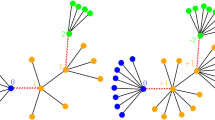Abstract
Using the ordered analogue of Farley–Sabalka’s discrete gradient field on the configuration space of a graph, we unravel a levelwise behavior of the generators of the pure braid group on a tree. This allows us to generalize Farber’s equivariant description of the homotopy type of the configuration space on a tree on two particles. The results are applied to the calculation of all the higher topological complexities of ordered configuration spaces on trees on any number of particles.







Similar content being viewed by others
Notes
All cohomology groups in this paper are taken with \({\mathbb {Z}}\)-coefficients.
It suffices to totally order the non-deleted edges adjacent to v.
Stacks like these are uniquely determined, as the tree has been assumed to be n-sufficiently subdivided.
In this kind of expressions we extend, in the obvious way, the abuse of terminology in (10).
An \(a_0\)-local T-branch is a sequence of edges \((a_0,b), (b,c), (c,d),\ldots \) (it implies \(a_0<b<c<d<\ldots \)).
References
Abrams, A.D.: Configuration Spaces and Braid Groups of Graphs. PhD thesis, University of California, Berkeley (2000)
Basabe, I., González, J., Rudyak, Y.B., Tamaki, D.: Higher topological complexity and its symmetrization. Algebr. Geom. Topol. 14(4), 2103–2124 (2014)
Chettih, S.: Dancing in the Stars: Topology of Non-\(k\)-Equal Configuration Spaces of Graphs. PhD thesis, University of Oregon (2016)
Cornea, O., Lupton, G., Oprea, J., Tanré, D.: Lusternik–Schnirelmann Category. Mathematical Surveys and Monographs, vol. 103. American Mathematical Society, Providence (2003)
Farber, M.: Configuration spaces and robot motion planning algorithms. In: Combinatorial and Toric Homotopy. Lecture Notes Series, Institute for Mathematical Sciences, National University of Singapore, vol. 35, pp. 263–303. World Scientific, Hackensack (2018)
Farley, D., Sabalka, L.: Discrete Morse theory and graph braid groups. Algebr. Geom. Topol. 5, 1075–1109 (2005)
Farley, D., Sabalka, L.: Presentations of graph braid groups. Forum Math. 24(4), 827–859 (2012)
Forman, R.: Morse theory for cell complexes. Adv. Math. 134(1), 90–145 (1998)
Freij, R.: Equivariant discrete Morse theory. Discrete Math. 309(12), 3821–3829 (2009)
Grant, M., Lupton, G., Oprea, J.: Spaces of topological complexity one. Homol. Homotopy Appl. 15(2), 73–81 (2013)
Kim, J.H., Ko, K.H., Park, H.W.: Graph braid groups and right-angled Artin groups. Trans. Am. Math. Soc. 364(1), 309–360 (2012)
Lütgehetmann, D., Recio-Mitter, D.: Topological complexity of configuration spaces of fully articulated graphs and banana graphs. Discrete Comput. Geom. 65(3), 693–712 (2021)
Scheirer, S.: Topological complexity of \(n\) points on a tree. Algebr. Geom. Topol. 18(2), 839–876 (2018)
Author information
Authors and Affiliations
Corresponding author
Additional information
Editor in Charge: János Pach
Publisher's Note
Springer Nature remains neutral with regard to jurisdictional claims in published maps and institutional affiliations.
Rights and permissions
About this article
Cite this article
Aguilar-Guzmán, J., González, J. & Hoekstra-Mendoza, T. Farley–Sabalka’s Morse-Theory Model and the Higher Topological Complexity of Ordered Configuration Spaces on Trees. Discrete Comput Geom 67, 258–286 (2022). https://doi.org/10.1007/s00454-021-00306-3
Received:
Revised:
Accepted:
Published:
Issue Date:
DOI: https://doi.org/10.1007/s00454-021-00306-3
Keywords
- Discretized configuration space on a tree
- Discrete Morse theory
- Farley–Sabalka gradient field
- Topological complexity



